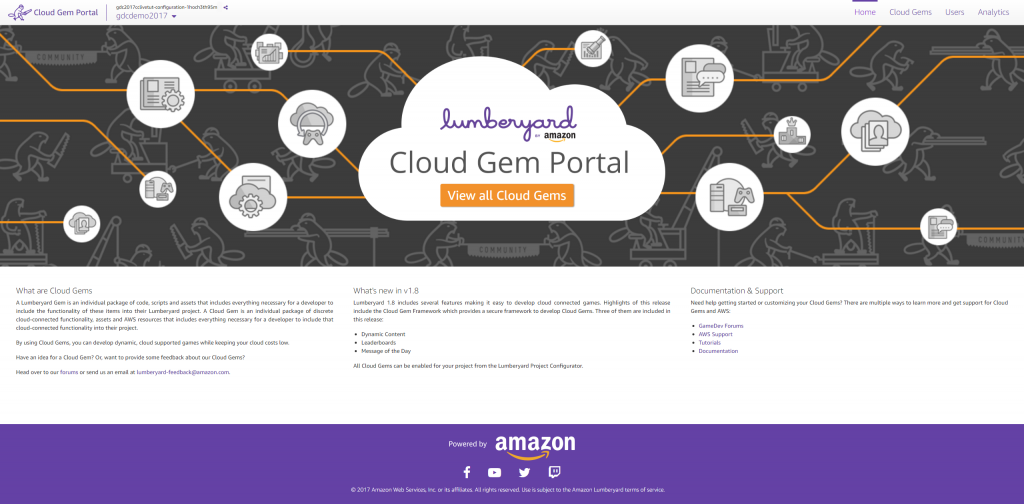AWS for Games Blog
Now Available – Lumberyard Beta 1.8, Introducing the Cloud Gems Framework
 We’re excited to announce the release of Lumberyard Beta 1.8, which you can download here. This release contains over 234 new improvements, fixes, and features, and introduces Cloud Gems Framework, a new framework designed to help you build popular cloud-connected features in as little as 30 minutes with one engineer.
We’re excited to announce the release of Lumberyard Beta 1.8, which you can download here. This release contains over 234 new improvements, fixes, and features, and introduces Cloud Gems Framework, a new framework designed to help you build popular cloud-connected features in as little as 30 minutes with one engineer.
As AWS, we are fortunate to work with many of the industry’s best game studios, from the earliest pioneers in mobile and social, like Supercell and Zynga, to PC and console developers with galaxy-sized ambitions, like Cloud Imperium and Leslie Benzies’ Everywhere. We’ve seen developers harness the cloud for innovation and growth, connecting players together at a scale that was previously impossible, enabling new forms of competition and gameplay, and giving their teams deep and real-time insights into what their players like – and don’t like – about their games.
Customers tell us that as important as the vast compute and storage of the cloud is to their successful games today, the cloud will become even more critical to the creativity and scale of the next generation of games. The amount of developer demand for connecting global audiences, using mass compute to push creativity, and building more social and multiplayer features, made “deeply integrated with AWS” a founding pillar of Lumberyard.
We define “deeply integrated” in two ways. One, we want to make it as easy as possible for you to build common connected elements, like multiplayer, social features, and dynamic and live content updates, in your game. We want you to focus on great gameplay, not hiring expert backend engineers and spending months or years building undifferentiated infrastructure. Next, we aspire to help you create fantastic new types of gameplay and real-time interactions made possible by massive on-demand, global compute and storage. Here, we’re inspired by the game teams thinking about procedural gameplay, complex artificial intelligence, and games of huge scale and incredible fidelity.
Lumberyard Beta 1.8’s new Cloud Gems Framework makes it easier for you to build and launch connected game elements, such as dynamic content, leaderboards, and live messages. With the Cloud Gems Framework, you can add a connected feature to your game in as little as 30 minutes, with one engineer, freeing up the rest of your team to think about innovation and player experience.
The Cloud Gems Framework is made up of the Cloud Gem Portal, a web application that lets anyone on your team visually manage your cloud features (e.g. scheduling messages, releasing dynamic content, or deleting a fraudulent leaderboard score), and Cloud Gems – modular packages of discrete functionality and assets that include everything necessary for a developer to include that functionality into their project, including backend and client functionality. Cloud Gems can be used out of the box in production, and they come with full source code in case you want to customize their behavior in whatever way you choose.
Lumberyard Beta 1.8 includes three sample Cloud Gems to help you get started quickly:
Dynamic Content Cloud Gem
Many of today’s successful games are live and “always-on.” Teams want to be able to better engage players by adding and changing content frequently, with as little friction as possible to the development team. With a dynamic content backend, your team can quickly respond to player feedback, offer special characters, A/B test gameplay features, or just add new characters or levels to a game to extend its life – all without requiring your players to download an updated executable and install it themselves.
To build a dynamic content system yourself, you would need to stand up servers to host the content, create a scheme to specify what dynamic content is available, deal with versioning of the content, build tools to upload the content to your servers, write engine code that queries your server to see when content has changed, build a robust downloading and verification system, and finally write the code that hot-loads that content into a running instance of your game. This work could take 2-3 engineers several months to get right, and if this system fails, players may never see the content your team worked hard to create.
With the Dynamic Content Cloud Gem, you can package, upload, and deliver content to your players in as few as 7 steps:
- Enable the Dynamic Content Gem in Lumberyard Project Configurator
- Click “Upload Resources” from the Cloud Canvas Resource Manager
- Open the Dynamic Content Manager from the Editor’s AWS menu
- Create the manifest that lists your dynamic content
- Click “New Package” from the Dynamic Content Manager
- Drag and drop the assets you want to upload
- Click “Upload Packages” from the dynamic content manager. This puts the content in the cloud and marks it as private.
Once your content is uploaded to the cloud, you can use the Cloud Gem Portal to release your content immediately or schedule the content for release later, letting you determine exactly when players receive the updates to your game. When the new content has been downloaded by the player, the Dynamic Content Gem automatically loads the new content and makes it available in the game.
Leaderboards Cloud Gem
Competition is a great way to foster player community – in January, eight of the top ten games watched on Twitch were competitive multiplayer games. Adding a leaderboard to your game is a popular way to encourage competition in your community. Traditionally, to set up a leaderboard, you would have to provision database servers (in a scalable manner) to store the high score data, write and deploy REST endpoints to gather the scores, write a web-based console or other application to manage the high score data on the server, and teach client-side developers how to make appropriate network calls to send the player’s score to the REST endpoint. With the Leaderboard Cloud Gem, this is simplified to 4 steps that an engineer can accomplish in about 30 minutes
- Enable the Leaderboard Cloud Gem in Project Configurator.
- Click “Upload Resources” from the Cloud Canvas Resource Manager.
- In the Cloud Gem Portal, create as many leaderboards as you want based on the statistics on which you want to rank your players.
- Send the player’s score or other data to the cloud at appropriate intervals using simple calls to the Leaderboard component from script or C++.
The Cloud Gem Portal also provides a console for managing the players on the leaderboard, and allows an administrator to delete fraudulent scores and ban players that abuse the system.
Message of the Day Cloud Gem
Another way to foster engagement is by sending messages to your players at opportune moments, whether to notify them of special offers, new content updates, or send any other timely communication as you wish. Traditionally, you would need to provision and configure a set of scalable database servers, write a web-based application to manage the entry, modification, deletion, and scheduling of the message content, write REST endpoints to serve the message content, and write client-side game code to request the messages and display them. Using the Message of the Day Cloud Gem you can get there, again in 4 steps and about 30 minutes:
- Enable the Message of the Day Cloud Gem in Project Configurator.
- Click “Upload Resources” from the Cloud Canvas Resource Manager.
- In the Cloud Gem Portal, create and schedule as many messages as you want.
- Query the list of active messages from Message of the Day component using simple calls from script or C++.
We have more Cloud Gems in development, so if you have any particular cloud functionality you want to see next, let us know on the forums. Also, if you’re going to be at GDC next week, stop by the Lumberyard booth to meet the Cloud Canvas team and get a hands-on demonstration of Cloud Gems, or sign up for our GDC devday to watch us take a game from zero to cloud-connected in real time. We’ll also provide some glimpses at our future vision for how the AWS cloud can enable new types of gameplay and real-time interactions.
There’s lots more to Lumberyard Beta 1.8, too. You’ll find a streamlined information architecture of our menus in Lumberyard Editor, root motion animation support in the FBX importer, mobile and console support for the multiplayer sample, multi-UV support for meshes, language support in the UI editor, and more. For details on everything new in this release, check out the full release notes.
To get started with Amazon Lumberyard, please visit the Lumberyard website to download the engine. You can learn more about Lumberyard’s new features by watching our Tutorials, visiting the Forums, or reading through our Documentation.
